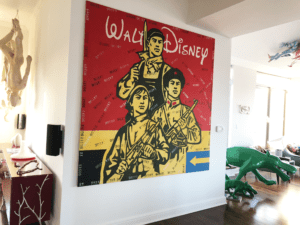We’re kicking off our 2019 #ArtPowerWomen Series with a contemporary Russian-American artist who illuminates the beauty and power of the feminine spirit through her figurative paintings. Winters creates vivid portraits of women, transforming her private, inner world into complex visual stories. With elegant color and romantic compositions, the artist offers worlds of peace to overcome the darkness we all face. Her practice grows from a deep desire to celebrate beauty, uncover our true selves, and help women find their strength.
Highly symbolic and influenced by classical artistic traditions, Winters’ work serves as a tool—for herself and her viewers alike—to experience the healing potential of painting.Veronica Winters
We caught up with Winters to discuss her practice, what influences her and what draws her to figurative painting.
AZ: Where are you currently based?
Veronica Winters: I live in Naples, Florida.
AZ:Favorite museum?
VW: I have two favorites- the Hermitage in St. Petersburg, Russia and the Met in New York. Both have exceptional art collections on display. I used to go to the Met not only for the amazing exhibitions, but also to copy Greco-Roman sculptures in their galleries. The Hermitage offers a rich history of Russian and European culture in over three million items located in the Winter Palace complex of buildings. My imagination runs wild in that museum.
AZ: You never leave home without?
VW: My phone because it has a notepad to keep notes of my thoughts anywhere I go. My ideas for the paintings arise in weird places like at the gym or on a beach walk. Sometimes I write a descriptive sentence of a painting and other times I “sketch” a paragraph describing a feeling, pose, props, color scheme and location of my photoshoot.
AZ: Your Insta handle is @paintingfemininebeauty. Why is painting beauty, especially feminine beauty, such an important part of your work?
VW: Feminine beauty has a vast history in art. Artists painted clothed and nude women illustrating scenes from the Bible and mythology. Women were largely cultural symbols in the past and are individuals in the present. The depiction of women often has a sexual connotation in contemporary paintings. I paint neither idealized nor sexualized female beauty. Rather I associate the Feminine with the spirit and emotions we experience. Models are just vehicles to capture that. In other words, I paint an idea or a feeling symbolized in a female form. For classically trained artists, beauty, is the ultimate goal to visually depict the truth the artist sees in someone or something. Therefore, it becomes a chase of the beautiful for me as well but it’s done in a different projection.

AZ: Although you’re influenced by periods in which the male gaze dominated, how do your female subjects differ from theirs?
VW: I paint from a female perspective focusing on the interior life of women expressed through symbols and figure. Titles of my paintings suggest the main idea for the artwork, which is states of being (silent, abandoned, invisible, where joy blooms, loving heart, faith, sacred, carrying the light, etc.). I don’t derive my main inspiration from physical attributes of girls, although I find women beautiful and try to capture their most ethereal side. I’m a woman and I paint what I know. While I don’t see myself painting a male form exclusively, it’s possible to paint both sexes to tell a story in art in my future work.
AZ: What is it about figurative painting that draws you?
VW: Figurative painting is the hardest to master if you work in the realist tradition. When I was an art student I thought I’d never get to paint a human form because of so many limitations I had in my mind. First, I began drawing in college as an adult after having a baby and one degree already, I had no talent in depicting the figure. I drew stick figures, so it took me much longer to get the skill going in figurative drawing as opposed to some students I saw in my classes. Second, two decades ago it was incredibly hard to find a college teacher who painted in classical tradition. Despite that, I kept moving towards figurative painting in strides. I think it happened because I could finally explore the human condition as allegory. Figurative painting combines symbolism and imagination. It lets me be both representational and imaginative. In my still life work I couldn’t put much emotion into the objects I painted although it was a great stepping stone to learn composition, color and traditional oil painting techniques. Figurative painting carries a lot more expression, in my opinion when it’s not formal or constrained.
AZ: How do you come up with the poses for your works? Do you have them in mind before you start creating or is it more spontaneous?
VW: It goes both ways. When I have a photoshoot we start with the “requested” poses. I often show a position that the model mimics for me or I give her a magazine picture, explaining what I like about a specific pose captured there. After a while, the person feels comfortable in front of the camera and I get a gesture that’s natural and not superimposed. So it’s a combination of creativity, preconceived ideas and model’s confidence. I do as much composing as possible with my camera, so when I look at my pictures they are already finished paintings in a way.
After that I create a final visual story around the image in Photoshop by combining different references. It took me years to understand how to see the light, capture it, and use it to my advantage. We want to get things fast, but it’s actually a slow, intellectual process of understanding how to set up everything to achieve visual harmony.

AZ: You mentioned you are influenced by 19th-century art and the Baroque, what is it about the art in these periods that inspires you?
VW: Baroque for exuberance, classical roots, creativity and artistic imagination. There is a split in the 19th-century art between the Academic painting and new art forms. The Impressionists taught me how to see color. The Pre-Raphaelites and the Itinerants taught me to seek stories in art. Mucha and Klimt taught me stylization. Leighton and Bouguereau gave me a high standard of ethereal grace and elegance to aspire to in my art.
AZ: Your color palettes are striking. Why and how do you decide which colors to use?
VW: Color describes our moods. Red is fierce. Blue is calm. Purple is serene. Yellow can be joyful. I start there, then I find a complementary color to the main one. (Blue-yellow). Also, I take notes of color schemes I see in nature and masterworks. For example, when I walk on the beach before the sunset, there is a lot of pink-turquoise in the sky and water. I use that in my art.
AZ: When is your favorite time to create art?
VW: When I don’t teach, I paint. I can paint for 12 hours straight if I don’t have other commitments and that translates to painting from morning till about 10:30 pm. Painting is an obsessive desire, a compulsion for me that has no time constraints. It’s a very slow process. I complete 1-2 paintings in a month.
AZ: You teach classes at your studio. What’s the best part of teaching for you?
VW: I used to teach adult classes for the most part. Now I mainly work with teenagers in my studio. My goal is to pass on the skill to them. That’s the reason for their coming, but most importantly, I want to give them something I’ve never had as a child – confidence, a sense of their uniqueness or identity and belief in oneself.

AZ: What do you have coming up?
VW: I have finished working on my first online course in colored pencil drawing that’s based on my published book with Dover “The Colored Pencil Manual.” I’m also working on a second class devoted to portrait drawing in colored pencil because I have many requests from artists to do that.
Mainly, I want to make a significant contribution to the contemporary art scene with my paintings of women and eventually to have a show in a gallery or museum space in the future. I’ll begin with a group show at the Marco Island center for the Arts, FL in May and I’ll show one painting at the TRAC 2019 representational art conference in California in April where one of my works is the 2nd place winner.
#ArtWomenSeries is a pro bono collaboration with Curatious and GirlSeesArt that highlights talented unrepresented women artists. To be considered for the series, post your work with #artpowerwomen.



